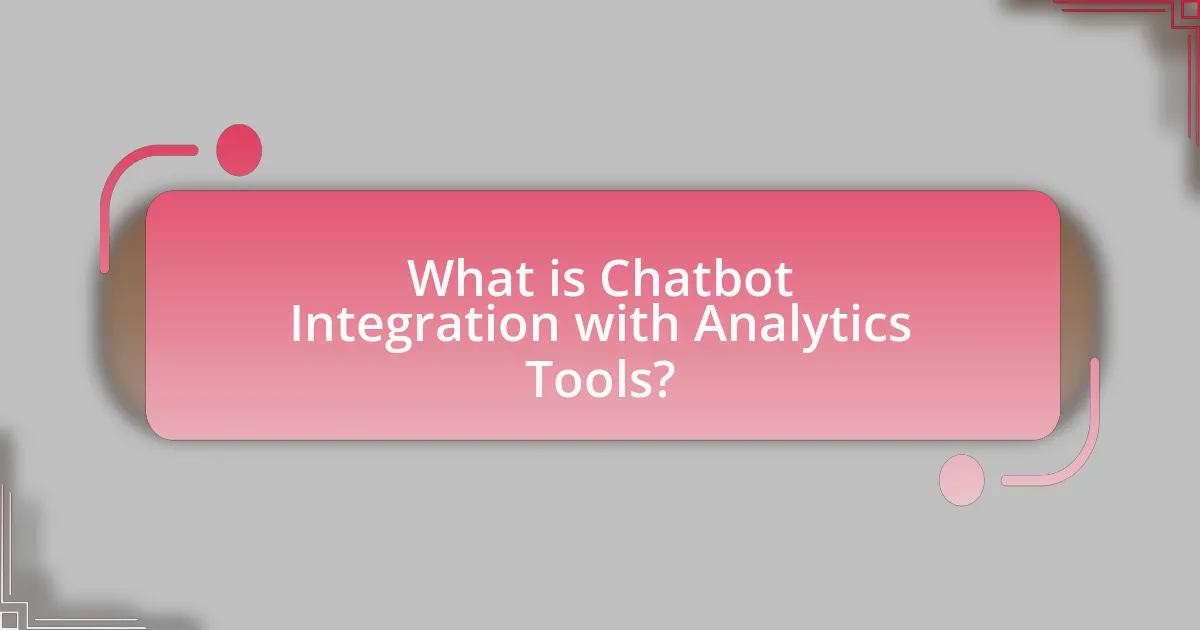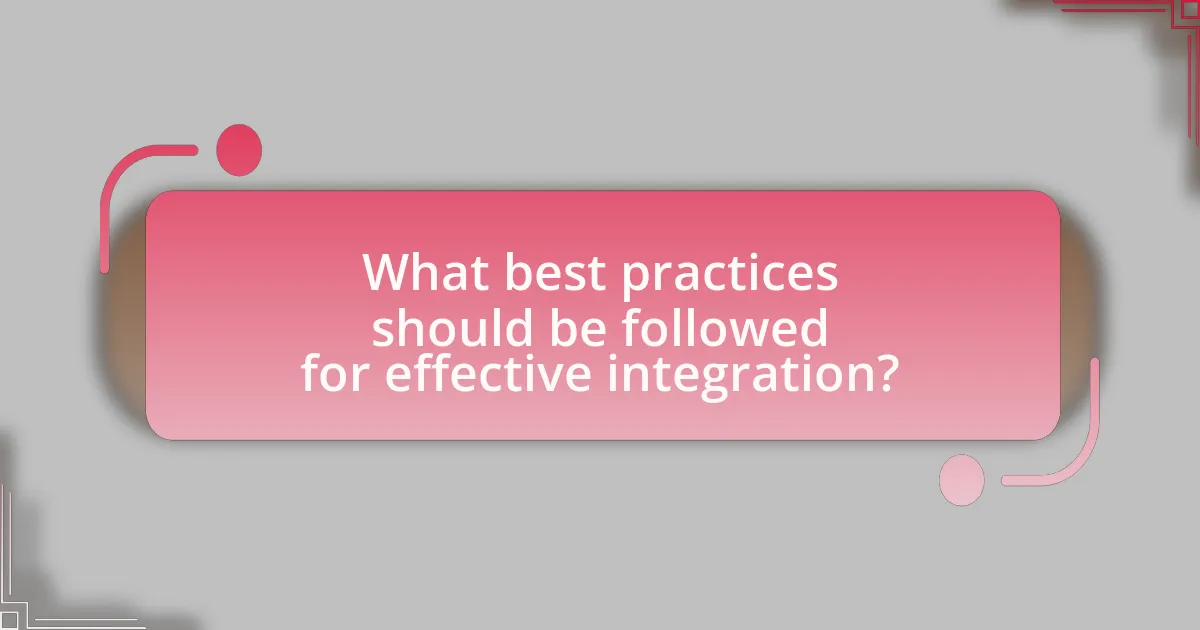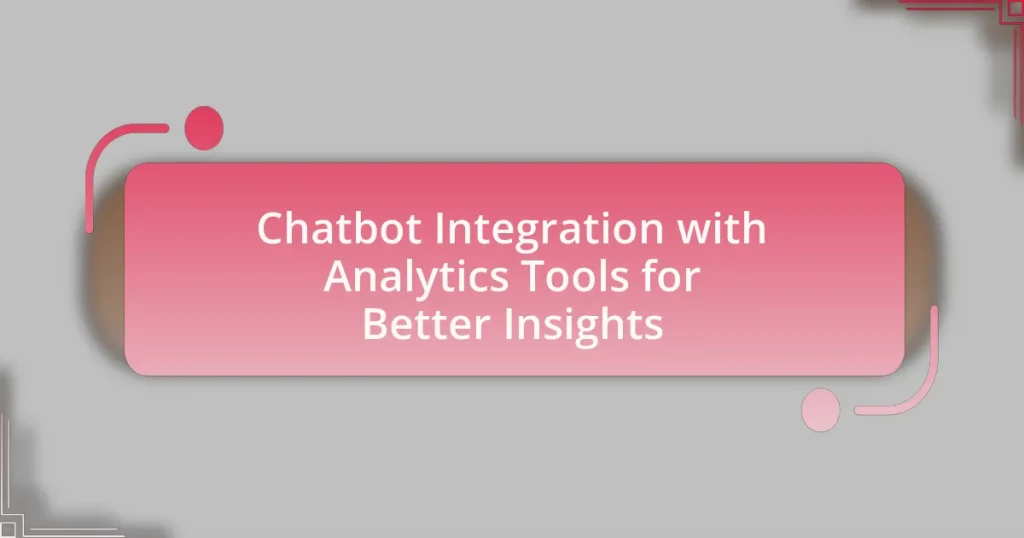Chatbot integration with analytics tools is the process of connecting chatbots to data analytics platforms to enhance data collection, analysis, and reporting. This integration allows businesses to track user interactions, gather insights on customer behavior, and measure chatbot performance, ultimately improving decision-making and operational efficiency. Key technologies facilitating this integration include APIs, Natural Language Processing frameworks, and cloud-based platforms, which enable real-time data exchange and analysis. The article explores the importance of this integration, the insights gained, the challenges faced, and best practices for successful implementation across various industries, highlighting the significant benefits for businesses in enhancing customer engagement and optimizing operational strategies.

What is Chatbot Integration with Analytics Tools?
Chatbot integration with analytics tools refers to the process of connecting chatbots to data analytics platforms to enhance data collection, analysis, and reporting. This integration allows businesses to track user interactions, gather insights on customer behavior, and measure the effectiveness of chatbot performance. For instance, integrating a chatbot with Google Analytics enables the collection of metrics such as user engagement rates and conversation paths, which can inform marketing strategies and improve customer service. This capability is supported by the fact that 70% of organizations that utilize analytics tools report improved decision-making and operational efficiency.
How do chatbots integrate with analytics tools?
Chatbots integrate with analytics tools by utilizing APIs to send and receive data, enabling real-time tracking of user interactions and performance metrics. This integration allows businesses to analyze conversation data, user behavior, and engagement levels, which can be visualized through dashboards in analytics platforms. For instance, tools like Google Analytics can capture chatbot interactions, providing insights into user demographics and session durations, thereby enhancing decision-making processes.
What technologies enable chatbot and analytics tool integration?
Technologies that enable chatbot and analytics tool integration include Application Programming Interfaces (APIs), Natural Language Processing (NLP) frameworks, and cloud-based platforms. APIs facilitate communication between chatbots and analytics tools, allowing data exchange and functionality integration. NLP frameworks enhance the chatbot’s ability to understand and process user inputs, which can then be analyzed for insights. Cloud-based platforms provide scalable infrastructure for storing and processing data, enabling real-time analytics and reporting. These technologies collectively enhance the effectiveness of chatbots in delivering actionable insights through analytics integration.
How do APIs facilitate this integration?
APIs facilitate integration by enabling seamless communication between chatbots and analytics tools. They allow chatbots to send and receive data, such as user interactions and engagement metrics, directly to analytics platforms. This data exchange enhances the ability to analyze user behavior and improve chatbot performance. For instance, APIs can provide real-time data transfer, ensuring that analytics tools receive up-to-date information for accurate insights. According to a report by Gartner, organizations that effectively utilize APIs can improve their operational efficiency by up to 30%, demonstrating the significant impact of APIs on integration processes.
Why is chatbot integration with analytics important?
Chatbot integration with analytics is important because it enables businesses to gather actionable insights from user interactions. By analyzing data from chatbot conversations, organizations can identify customer preferences, pain points, and behavior patterns, which can inform product development and marketing strategies. For instance, a study by McKinsey found that companies leveraging analytics can improve their decision-making processes by up to 5 times, demonstrating the significant impact of data-driven insights on business performance.
What insights can be gained from this integration?
The integration of chatbots with analytics tools provides insights into user behavior and engagement patterns. By analyzing interaction data, organizations can identify frequently asked questions, peak usage times, and user satisfaction levels. For instance, a study by Gartner indicates that businesses using chatbots can improve customer satisfaction by up to 80% through personalized interactions based on analytics. This data-driven approach enables companies to refine their chatbot responses, enhance user experience, and ultimately drive higher conversion rates.
How does it enhance user experience?
Chatbot integration with analytics tools enhances user experience by providing personalized interactions based on data-driven insights. This integration allows chatbots to analyze user behavior and preferences, enabling them to deliver tailored responses and recommendations. For instance, a study by Gartner indicates that businesses utilizing chatbots can improve customer satisfaction by up to 70% through enhanced personalization and timely assistance. By leveraging analytics, chatbots can also identify common user queries and optimize their responses, further streamlining the interaction process and reducing wait times.
What challenges are faced in chatbot integration with analytics tools?
Chatbot integration with analytics tools faces several challenges, primarily related to data compatibility, real-time processing, and user privacy concerns. Data compatibility issues arise when chatbots and analytics tools utilize different data formats or structures, making it difficult to synchronize and analyze data effectively. Real-time processing challenges occur when chatbots generate large volumes of data that analytics tools must process instantly to provide actionable insights, which can strain system resources. Additionally, user privacy concerns complicate integration, as compliance with regulations like GDPR requires careful handling of personal data collected through chatbots. These challenges hinder the seamless integration necessary for deriving meaningful insights from chatbot interactions.
What technical issues can arise during integration?
Technical issues that can arise during integration include data compatibility problems, API mismatches, and security vulnerabilities. Data compatibility problems occur when the formats or structures of data from the chatbot and analytics tools do not align, leading to errors in data interpretation. API mismatches can happen if the versions of the APIs used by the chatbot and the analytics tools are not compatible, resulting in failed connections or data transfer issues. Security vulnerabilities may arise if proper authentication and authorization measures are not implemented, exposing sensitive data to unauthorized access. These issues can significantly hinder the effectiveness of chatbot integration with analytics tools, impacting the quality of insights derived from the data.
How can data privacy concerns affect integration efforts?
Data privacy concerns can significantly hinder integration efforts by creating barriers to data sharing and collaboration. When organizations prioritize data privacy, they often implement strict compliance measures, which can slow down the integration process. For instance, regulations like the General Data Protection Regulation (GDPR) impose stringent requirements on how personal data is collected, processed, and shared, leading to delays in integrating analytics tools with chatbots. Additionally, fear of data breaches can result in organizations being hesitant to share data across platforms, ultimately limiting the effectiveness of integrated systems and reducing the potential for actionable insights.

How can businesses leverage chatbot integration with analytics tools?
Businesses can leverage chatbot integration with analytics tools by utilizing data collected from chatbot interactions to gain insights into customer behavior and preferences. This integration allows businesses to analyze conversation patterns, identify frequently asked questions, and measure customer satisfaction through sentiment analysis. For instance, a study by Salesforce found that 69% of consumers prefer chatbots for quick communication with brands, indicating the importance of understanding customer interactions. By analyzing this data, businesses can optimize their chatbot responses, improve customer service, and tailor marketing strategies to better meet customer needs.
What are the key benefits for businesses?
The key benefits for businesses integrating chatbots with analytics tools include enhanced customer engagement, improved data-driven decision-making, and increased operational efficiency. Enhanced customer engagement occurs as chatbots provide instant responses and personalized interactions, leading to higher satisfaction rates. Improved data-driven decision-making is facilitated by the analytics tools that gather and analyze customer interactions, allowing businesses to identify trends and preferences. Increased operational efficiency results from automating routine inquiries, freeing up human resources for more complex tasks. According to a report by Gartner, businesses that utilize chatbots can reduce operational costs by up to 30%, demonstrating the financial advantages of this integration.
How does it improve decision-making processes?
Chatbot integration with analytics tools improves decision-making processes by providing real-time data insights and automating data analysis. This integration allows organizations to gather and analyze customer interactions, preferences, and behaviors efficiently, leading to informed decisions. For instance, a study by Gartner indicates that organizations utilizing AI-driven analytics can enhance their decision-making speed by up to 5 times, as they can quickly interpret large volumes of data without manual intervention. This capability enables businesses to respond promptly to market changes and customer needs, ultimately driving better strategic outcomes.
What role does it play in customer engagement strategies?
Chatbot integration with analytics tools plays a crucial role in customer engagement strategies by providing real-time insights into customer behavior and preferences. This integration allows businesses to analyze interactions, identify trends, and tailor responses, enhancing the overall customer experience. For instance, a study by Gartner indicates that organizations using chatbots can improve customer satisfaction by up to 70% due to personalized interactions driven by data analysis. By leveraging analytics, companies can optimize chatbot performance, ensuring that customer inquiries are addressed promptly and accurately, which fosters stronger customer relationships.
What industries can benefit from this integration?
Industries that can benefit from chatbot integration with analytics tools include e-commerce, healthcare, finance, and customer service. E-commerce companies can leverage chatbots to enhance customer engagement and analyze purchasing behavior, leading to improved sales strategies. Healthcare providers can utilize chatbots for patient interaction and data collection, which can be analyzed to optimize patient care and operational efficiency. The finance sector can implement chatbots for customer inquiries and transaction analysis, allowing for better risk management and personalized services. Customer service across various sectors can enhance response times and satisfaction by analyzing chatbot interactions to identify common issues and improve service delivery.
How do e-commerce businesses utilize chatbot analytics?
E-commerce businesses utilize chatbot analytics to enhance customer engagement and optimize sales strategies. By analyzing interactions, businesses can identify customer preferences, common inquiries, and pain points, allowing them to tailor their offerings and improve service quality. For instance, data from chatbot conversations can reveal peak inquiry times, enabling businesses to allocate resources effectively. Additionally, metrics such as response time and resolution rates provide insights into chatbot performance, guiding improvements in AI training and user experience. This data-driven approach leads to increased customer satisfaction and higher conversion rates, as evidenced by a study from Juniper Research, which estimates that chatbots will help businesses save over $8 billion annually by 2022 through improved customer service efficiency.
What advantages do service industries gain from this integration?
Service industries gain enhanced customer insights and improved operational efficiency from the integration of chatbots with analytics tools. This integration allows businesses to collect and analyze customer interaction data in real-time, leading to more informed decision-making. For instance, a study by McKinsey & Company found that companies leveraging data analytics can increase their productivity by up to 20%. Additionally, the integration facilitates personalized customer experiences by analyzing preferences and behaviors, which can lead to higher customer satisfaction and retention rates.

What best practices should be followed for effective integration?
Effective integration of chatbots with analytics tools requires following best practices such as ensuring data compatibility, establishing clear objectives, and maintaining ongoing communication between teams. Data compatibility ensures that the chatbot can seamlessly exchange information with analytics tools, which is crucial for accurate insights. Establishing clear objectives helps define what metrics and outcomes are desired from the integration, guiding the development process. Ongoing communication between development and analytics teams fosters collaboration, allowing for adjustments based on real-time feedback and performance metrics. These practices enhance the overall effectiveness of the integration, leading to improved insights and decision-making.
How can businesses ensure successful integration?
Businesses can ensure successful integration of chatbots with analytics tools by establishing clear objectives and aligning them with the capabilities of the tools. This involves defining specific metrics for success, such as user engagement rates and conversion metrics, which can be tracked through analytics platforms. Research indicates that organizations that set measurable goals are 30% more likely to achieve successful integration outcomes. Additionally, providing comprehensive training for staff on both the chatbot and analytics tools enhances user adoption and maximizes the effectiveness of the integration.
What steps should be taken during the planning phase?
During the planning phase of chatbot integration with analytics tools, the key steps include defining objectives, identifying target users, selecting appropriate analytics tools, mapping user journeys, and establishing metrics for success. Defining objectives ensures clarity on what the integration aims to achieve, such as improving user engagement or enhancing data collection. Identifying target users helps tailor the chatbot’s functionality to meet specific needs. Selecting appropriate analytics tools, such as Google Analytics or Mixpanel, allows for effective data tracking and analysis. Mapping user journeys provides insights into user interactions, which informs the design and functionality of the chatbot. Establishing metrics for success, such as conversion rates or user satisfaction scores, enables measurement of the integration’s effectiveness. These steps are essential for a successful planning phase in chatbot integration with analytics tools.
How can ongoing monitoring improve integration outcomes?
Ongoing monitoring can significantly improve integration outcomes by providing real-time data analysis and feedback, which allows for timely adjustments and enhancements. This continuous oversight enables organizations to identify issues promptly, optimize performance, and ensure that the integration of chatbots with analytics tools aligns with business objectives. For instance, a study by McKinsey found that companies utilizing real-time data monitoring can increase their operational efficiency by up to 20%. By leveraging ongoing monitoring, organizations can make data-driven decisions that enhance user experience and drive better insights from their chatbot integrations.
What common pitfalls should be avoided?
Common pitfalls to avoid in chatbot integration with analytics tools include inadequate data privacy measures, lack of clear objectives, and insufficient testing. Inadequate data privacy can lead to compliance issues, as regulations like GDPR require strict handling of user data. Lack of clear objectives can result in misaligned functionalities, making it difficult to measure success. Insufficient testing may cause technical glitches, leading to poor user experience and inaccurate data collection. Each of these pitfalls can significantly hinder the effectiveness of the integration and the insights derived from it.
How can businesses prevent data overload from analytics tools?
Businesses can prevent data overload from analytics tools by implementing data prioritization strategies. By focusing on key performance indicators (KPIs) that align with their objectives, organizations can streamline the data they analyze, reducing unnecessary complexity. Research indicates that companies that concentrate on a limited set of relevant metrics experience improved decision-making and operational efficiency. For instance, a study by McKinsey found that organizations that effectively prioritize data can enhance their productivity by up to 20%. This targeted approach allows businesses to extract actionable insights without being overwhelmed by excessive information.
What strategies can mitigate user resistance to chatbots?
To mitigate user resistance to chatbots, organizations should implement strategies such as enhancing user experience through intuitive design, providing clear communication about the chatbot’s capabilities, and ensuring seamless integration with existing systems. Research indicates that 70% of users prefer chatbots that are easy to navigate and understand, which emphasizes the importance of user-friendly interfaces. Additionally, educating users on the benefits of chatbots, such as 24/7 availability and quick response times, can further reduce resistance. A study by Gartner found that by 2022, 70% of customer interactions will involve emerging technologies like chatbots, highlighting the necessity for organizations to address user concerns proactively.
What practical tips can enhance chatbot integration with analytics tools?
To enhance chatbot integration with analytics tools, ensure seamless data flow between the chatbot and the analytics platform. This can be achieved by utilizing APIs that allow real-time data exchange, enabling the collection of user interactions and feedback. Additionally, implementing event tracking within the chatbot can provide insights into user behavior and preferences, which can be analyzed to improve the chatbot’s performance. For instance, a study by Gartner indicates that organizations leveraging integrated analytics can increase their customer satisfaction scores by up to 20%. Therefore, focusing on API integration and event tracking is essential for maximizing the effectiveness of chatbot analytics.










